Peter Lopez Jr.'s Blog: Xulon Press Blog , page 9
October 13, 2023
Standard Book Sizes (Trim Sizes) in Publishing

If you’ve wandered the aisles of a bookstore, you know that book sizes can vary a lot. But did you know each book genre has a standard set of trim sizes? Plus, the trim size and final page count of a book contribute to the retail price of each book. These choices are made by the publisher when books are traditionally published, but if you self-publish your book you’ll be responsible for choosing the trim size for your book.
Choosing the right trim size is determined by the genre of your book and a few other factors. For example, if you’re going to publish a children’s picture book, you may want to opt for a larger trim size to showcase your vibrant illustrations.
In this article, we’ll help you choose the best trim size for your book based on your genre.
What is a Trim Size?Before we delve into the standard book sizes, let’s first understand what a trim size is. A trim size is the final size of the book after it has been printed and trimmed. It is the physical dimensions of the book that readers will hold in their hands.
Industry Terms for Trim SizesIn the publishing industry, there are several important terms associated with trim sizes that you should become familiar with. These terms will help you understand the different aspects of book production and design. Here are three terms to know:
Trim size: This refers to the final size of the book, as we mentioned above after it has been printed and trimmed. It’s important to choose a trim size for your book that meets industry standards and reader expectations.Bleed: Bleed refers to the extra space around the edges of each page that is added to account for trimming once the pages have been printed. Bleed ensures that there are no white borders or large margin gaps when the book is trimmed to its final size.Gutter: The gutter is the inner margin of a book where the pages are bound together. It’s important to consider the gutter when designing a book layout to ensure that the text or images do not get lost in the binding.Our production team of typesetters and book designers automatically implement the required bleed and gutter specs to each book based on the trim size that is selected. The bleed and gutter specs are provided by our printer partners and ensure consistency as they print, trim, and bind books.
Standard Trim Sizes in PublishingFiction books come in various trim sizes depending on the genre and target audience. Here are some common trim sizes for fiction books:
4.25 x 7 inches: Also referred to as “mass market paperback,” this compact size is often used for popular fiction genres like romance and mystery.5.5 x 8.5 inches: Referred to as “trade paperback,” this is a slightly larger size that is typically used for general fiction and literary fiction.6 x 9 inches: Fiction hardcover books are most often printed in this trim size because the dimensions provide a more substantial experience when readers hold the bookInfographic of Standard Trim Sizes for Fiction
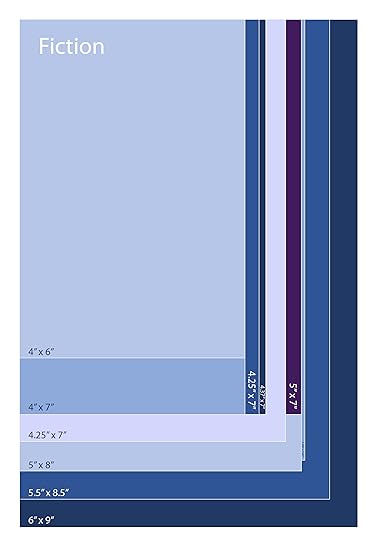
Nonfiction books also have a range of trim sizes based on the subject matter and intended readership. You’ll most often see 5.5 x 8.5 inches, 6 x 9 inches, and 7 x 10 inches used for various types of books within the nonfiction category. Memoirs are typically printed in the following trim sizes: 5.25 x 8 inches and 5.5 x 8.5 inches.
Infographic of Standard Trim Sizes for Nonfiction
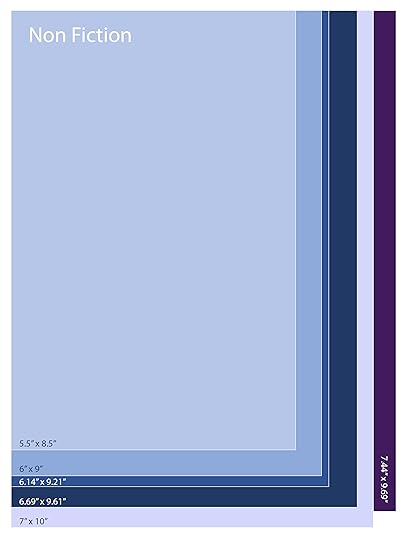
Devotional books tend to appear in a variety of trim sizes, with many of them falling with the 5.25 x 8-inch and 5.5 x 8.5-inch trim sizes. However, a growing number of hardcover devotionals are also being printed in (or close to) the 6 x 9-inch trim size or specs super close to this trim size.
Infographic of Standard Trim Sizes for Devotional Books
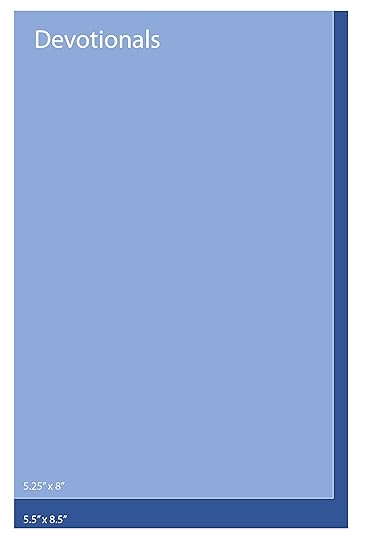
When it comes to poetry books, several standard trim sizes are commonly used in the publishing industry. Here are a few examples:
5.5 x 8.5 inches: This is the most common trim size for poetry books, which is a standard trade paperback size.6 x 9 inches: This is another popular trim size for poetry books because it’s a bit larger and provides more space on the page for longer poems7 x 10 inches: This larger trim size is good for poetry that will be accompanied by artwork.Infographic for Standard Trim Sizes of Poetry Books
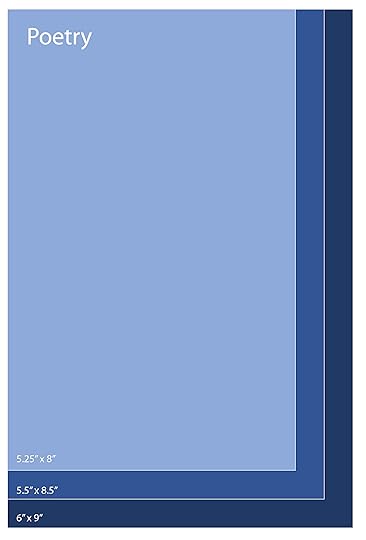
Workbooks and other activity books cater to different target audiences and their specific needs. When it comes to choosing the right size for these books, there are a few standard trim sizes available. We often recommend trim sizes of 6 x 9 inches, 7 x 10 inches, and 8.5 x 11 inches for workbooks. If you want to provide room for users to write within your workbook, the two larger trim sizes work best. If you’re producing more of a study guide, you may find the 6 x 9 to be the right size for your book.
Infographic of Standard Trim Sizes for Study Guides and Workbooks
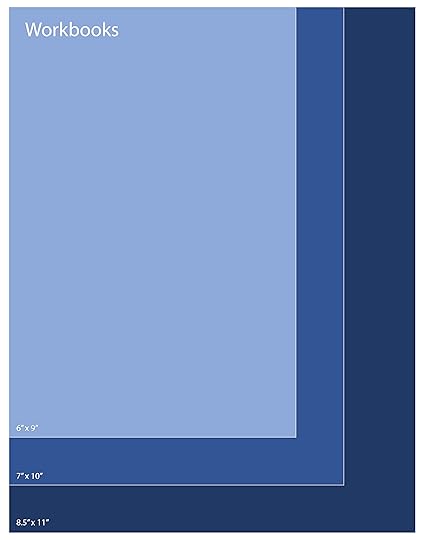
Cookbooks come in various trim sizes, depending on the layout and inclusion of photographs and/or illustrations. a cookbook’s trim size needs to accommodate and enhance readers’ overall cooking experiences. For cookbooks, we recommend no smaller than 8 x 8 inches. The largest size for cookbooks would be 8.5 x 11 inches.
Infographic of Standard Trim Sizes for Cookbooks
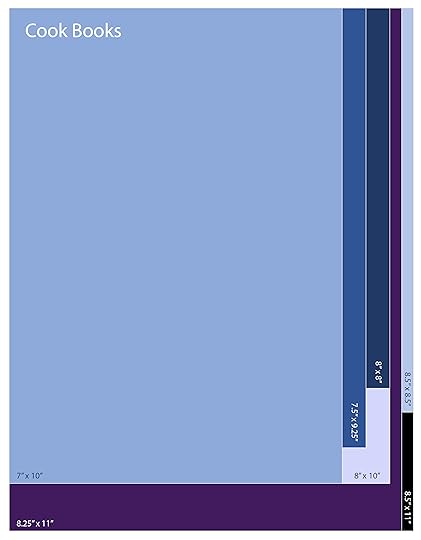
Children’s books come in a wide range of trim sizes to cater to different age groups and reading levels. You should choose a trim size that takes into consideration your illustrations, font size, and overall design of the book. You’ll find 7.5 x 7.5 inches, 7 x 10 inches, and 10 x 8 inches used most often for children’s books. And the 11 x 8.5 inches for a landscape book are a great size for large illustrations in a children’s book, too.
Infographic of Standard Trim Sizes for Children’s Books

Now that we’ve explored the standard trim sizes in publishing, let’s look at how to choose the right trim size for your book. Here are a few factors to consider:
1. GenreThe genre of your book is the singular biggest influence on your book’s trim size. Different genres have different reader expectations when it comes to the physical dimensions of a book. For example, romance novels often have smaller trim sizes, while coffee table books and workbooks often require larger trim sizes for readers to enjoy the photography or to find the workbook user-friendly.
2. Word Count and Page CountThe word count directly correlates to your total page count, and these also play a role in determining your book’s trim size. A book with a higher word count requires more pages to accommodate the text. So, you may decide to select a larger trim size within the standard set of book sizes for your genre, so your printed book isn’t too thick for readers to comfortably hold.
3. Retail Book PricingIt’s also important to note that trim size, final page count, and interior ink colors (black and white or color) determine a book’s production costs and retail pricing. Book retail pricing is set by book printers and they follow a standard pricing chart for all books—traditionally published or self-published.
Here’s an example:
A 100,000-word fiction manuscript formatted with black text and set in a mass market paperback size of 4.25 x 7 inches will produce a higher final page count number, which directly affects the retail price of the book.
Whereas, that same 100,000-word fiction manuscript formatted with black text in a 6 x 9-inch trim size will have a lower final page count number, which results in a lower retail price for the book.
The post Standard Book Sizes (Trim Sizes) in Publishing appeared first on Xulon Press.
October 6, 2023
Do Publishers Edit Your Book?

People often ask me whether publishers edit their books or not, and I always respond with “It depends.” If you choose the traditional publishing route, editors within your publishing house will not only edit your manuscript, but your literary agent will also make edits and note revisions for you to make. If you opt to self-publish your book, you will be responsible for having and paying for editing services for your manuscript.
In this post, we’ll explore how book editing works both when your book is traditionally published and when you self-publish your book.
How Book Editing Works When Your Book is Traditionally PublishedOnce you receive a publishing contract, an editor will collaborate with you to enhance your book’s quality. The editor will help you with a variety of editing tasks, including developmental editing, line editing, and copyediting.
During the developmental editing phase, your editor will help you to develop and refine the structure, content, and tone of your book. This process may involve suggesting changes to the overall plot, helping you to develop your characters more fully, or refining the pacing of your story. Once the developmental editing phase is complete, the editor will move your manuscript into line editing, which involves reviewing your manuscript line by line to ensure that the language is clear, concise, and effective.
Finally, during the copyediting phase, another editor will check your manuscript for errors in grammar, spelling, and punctuation. This part of the editing process is important to polish and eliminate errors from your story before it is printed.
Does This Cost the Author Any Money?If you traditionally publish your book, the publisher covers the cost of editing. However, the publisher will also take a cut of your book’s sales. This is how publishers make money, and it’s one of the main reasons why publishers are selective about the books they choose to publish.
How Book Editing Works When You Self-Publish Your BookIf you decide to self-publish your book, you’ll need to have it edited and cover the related expenses.
For instance, Xulon Press offers editorial services. Which is nice because you wouldn’t have to find an editor to work on your manuscript. Our editors offer developmental, line, and basic edits. Each level of editing does have a price per word associated with it. So, the overall investment in editing your manuscript will depend on your manuscript’s word count.
If you self-publish your book, the editing process may not be as extensive. In traditional publishing, the publisher’s editors would work on your manuscript and ensure that it is polished to perfection.
However, this doesn’t mean that you can’t get the same level of editing for your self-published book. You can choose to purchase multiple rounds of editing at different levels to guarantee that your manuscript undergoes thorough editing and refinement. This will aid in producing a high-quality book that your readers will appreciate and that will stand out in the competitive self-publishing market.
How Much Will Editing Run for an Author Who Is Self-Publishing a Book?Editing cost varies based on book length and required editing type. It’s important to keep in mind that the longer your book is, the more time it will take to edit.
If you decide to have your manuscript edited by a Xulon Press editor, you can expect to pay $0.035 to $0.125 per word depending on the level of editing you choose.
How to Get the Most Out of Editing When You’re Self-Publishing Your Book?To ensure that your manuscript is in the best shape possible, take these three steps before sending it off to an editor.
Take the time to revise and self-edit your work. This will help you catch any obvious errors or inconsistencies before someone else reads it.Share with beta readers. Once you feel confident in your manuscript, we recommend sharing it with beta readers to get their feedback. First readers typically provide valuable insights into areas of your manuscript that may need improvement or further development.Have a Manuscript Review or Critique completed first. We suggest having a Manuscript Review or Critique completed before you have a full edit done on your work. A professional editor performs these services and offers you additional revisions to improve your manuscript. Plus, you’ll get a personalized editing recommendation based on your manuscript.The post Do Publishers Edit Your Book? appeared first on Xulon Press.
September 29, 2023
One-Hour a Day to Your First Draft: The Ultimate Guide to Writing Your Book

Did you know all you need is an hour a day to write the first draft of your book?
We all have an hour a day to devote to writing. Even the busiest of us can find an hour a day to dedicate to our writing. Whether it’s waking up an hour earlier, cutting out some social media time, or skipping that television show binge session before bed, you can find the time if you’re committed.
In this article, we’ll discuss where to find your hour to write each day, how many words you can write in that time period, how consistency helps us as writers, and what to do with your writing hour if you have a case of writer’s block.
Can’t Find an Hour? Examine Your Days and Find Something You Can CutIf you’re having trouble finding an hour a day to write, you’re not alone. Many writers struggle to find the necessary time to dedicate to their craft. It’s important, however, to remember that writing a book is a significant time commitment, and it requires a consistent effort over a prolonged period of time to achieve your goals.
One strategy you can use to find an hour a day to write is to take a close look at your daily routine. Identify any tasks or activities that can be cut out or delegated to someone else. Are there any time wasters you can eliminate from your day? Can someone else take on some of your responsibilities to free up some time?
Another option is to break up your writing sessions into shorter chunks of time. Instead of writing for a full hour in one sitting, consider writing in 15- or 30-minute time blocks to reach a cumulative hour of writing every day.
If you truly cannot find an hour to write in your daily schedule, set your alarm for an hour earlier every morning and use that time to write before anyone else is up and before you have to complete your other responsibilities.
The key to writing for an hour a day is to create a consistent writing schedule. So, try to keep your writing time scheduled for the same time every day.
How Many Words Can a Writer Get on Paper in an Hour?The number of words you can write in an hour depends on your writing speed and the complexity of your ideas. On average, however, most writers can produce 500–1,000 words in an hour.
How Many Hour-Long Sessions to Complete the First Draft of a Book?Assuming you’re aiming to write a book with 80,000 words, you’ll need to write for a minimum of 80 hours to complete the first draft of your manuscript. That’s equals to a little more than 11 weeks to complete your first draft.
Why It’s Important to Work On Your Book Every DayJust like a plant needs daily attention to grow, your book needs daily attention in order for you to make progress. Consistency will help you achieve your writing goals. By writing every day, you develop a habit that keeps you on track. Additionally, consistent writing can help you identify any areas you may need to improve, and you’ll be better able to track your progress over time.
How Consistency Helps Us Become Better WritersWriting is a skill that can be honed by anyone over time and through consistent practice. The more you write, the more opportunities you’ll have to experiment with different styles and techniques, and the better you’ll become as a writer. When you are consistent with your writing, you’re able to improve your technical ability, and you’re able to develop a unique voice as a writer.
How to Use Your Writing Hour if Struggling with Writer’s BlockIf you find yourself dealing with a bout of writer’s block, don’t skip your writing time for the day. Instead, try using the Pomodoro Technique to refocus yourself. This technique involves setting a timer for twenty-five minutes. You’ll then use that time to freewrite or brainstorm. Don’t worry about perfection during this time; the only goal with this technique is to get your ideas down on paper.
Once the timer goes off, take a five-minute break to recharge. Then, you’ll set another twenty-five-minute time session.
If the Pomodoro Technique doesn’t help, use your hour for research that will add depth to your story or turn your focus back to your outline and make any improvements you see fit to your plot.
The post One-Hour a Day to Your First Draft: The Ultimate Guide to Writing Your Book appeared first on Xulon Press.
September 15, 2023
Recent Audiobook Trends Going Into Fall 2023

Are you curious about audiobooks and if you should have one produced for your self-published book? In this post, we’ll cover 2023 audiobook trends and statistics, how to have an audiobook produced, and why self-published authors may benefit from having an audiobook produced.
3 New Audiobook Trends (and Statistics) 20231. Audiobook Consumption Continues to RiseAccording to a 2023 survey by the Audio Publishers Association (APA), 53% of U.S. adults have listened to an audiobook, which is up from 45% in 2022. This shows that more and more people continue to turn to audiobooks as a form of entertainment.
2. Fiction Continues to be the Most Popular GenreFiction and Science Fiction/Fantasy continue to rule the audiobook market, but Humor, Non-Fiction, and Romance are currently the fastest growing genres for audiobooks, according to APA.
3. Audiobooks for Children is a Growing MarketOf audiobook listeners with children, 56% say their kids listen to audiobooks. While audiobooks for children make up just 3% of the total market, it had one of the fastest rates of growth in 2022, according to APA.
How Does Audiobook Production Work for Self-Published Authors?If you’re considering turning your book into an audiobook, you may be wondering what the production process entails. Typically, producing an audiobook involves hiring a narrator, recording the audio, and then editing and mastering the final product. But to save you time and effort of compiling an entire team to produce your audiobook, Xulon Press offers an audiobook service.
Why Should a Self-Published Author Turn Their Book into an Audiobook?Xulon Press audiobook pricing is available upon request and based on the total word count of your published book. Call 1-866-381-2665 (toll free) to speak with a Xulon Press Marketing Sales Representative. International callers may use 407-339-4217.
There are many benefits to turning your self-published book into an audiobook. For one, it helps you reach a wider audience—particularly readers who prefer to consume books in audio format. Audiobooks also make reading more accessible for people who are blind, people who have difficulty focusing on words in print, or people who are unable to hold a print book due to injury or illness, and more.
Where Do Readers Find Audiobooks to Listen to?Readers have many options available to them when it comes to places to find audiobooks. Some popular audiobook retailers include Audible, Apple Books, and Google Play Books. Many public libraries also offer digital audiobooks for loan, too.
Why Do People Listen to Audiobooks?Audiobooks gained immense popularity in recent times due to their convenience. It’s not just about listening to a story, but also having the ability to absorb new information or improve language skills.
Audiobooks provide an escape from the daily grind of our lives, just like print books, allowing us to immerse ourselves in another world. Plus, audiobooks offer the flexibility of being able to consume books while on the go because people don’t need to physically hold books. This provides a hands-free experience that can help reduce stress and fatigue.
Additionally, audiobooks provide the opportunity to listen to books in a different voice. This can give listeners a new perspective on a story.
The post Recent Audiobook Trends Going Into Fall 2023 appeared first on Xulon Press.
September 8, 2023
How to Write a Children’s Book

Writing a children’s book may be the most fun a writer can have, but there’s a lot more planning and research that goes into children’s books than you might think. From deciding on your reading audience to making the story age-appropriate and dialing in your story to the right Flesch-Kincaid reading level, we’re covering everything in this article that you need to know about writing a great children’s book.
There are five things every children’s book writer should keep in mind:
1. Decide On the Audience for Your Children’s BookSometimes the book idea comes first, and the idea will dictate your reading audience. Other times, you’ll need to decide on your target audience first. Are you writing a picture book that will be read aloud to babies or toddlers? Maybe you decide to write a picture book elementary school children can read to themselves. Each age group has different needs and interests, so it’s important to keep this in mind as you write.
2. Make the Story Age-AppropriateOnce you’ve decided on your audience, make sure that the story you’re telling is age-appropriate for them. Younger kids might not be ready for complex themes or hard to read words, while older kids may think simpler stories boring. Make sure the story you’re telling fits the intended age group of your book.
3. Use the Flesch-Kincaid Reading LevelThe Flesch-Kincaid Reading Level is a tool that helps you determine the reading level of your book. Flesch-Kincaid considers sentence length, word choice, and other factors to give you a score that indicates what grade level your book is suitable for. Make sure that your book’s reading level matches your target audience.
4. Follow Standard Word Counts for Children’s BooksChildren’s books come in many shapes and sizes, but there are some general parameters to follow regarding word count. Here are the standard word count ranges to keep in mind for picture books, early readers, chapter books and more:
Children’s Books
Picture Books: up to 500 wordsEarly Readers: 1,000–2,500 wordsChapter Books: 4,000–10,000 wordsMiddle Grade Chapter Books
20,000–50,000 wordsYoung Adult (YA) Books
55,000–80,000 wordsMake sure that your book’s word count is in the range for its intended audience.
5. Use an Illustrator for Picture BooksIf you’re writing a picture book, work with a professional illustrator to bring your story to life. A great artist can use illustrations to add emotion and depth to your story. Be sure to choose an illustrator who shares your vision for your book and has an artistic style that complements your story.
The post How to Write a Children’s Book appeared first on Xulon Press.
September 1, 2023
Writing Contests: What They are and How to Write a Winning Submission

Writing contests can be a great way to challenge yourself, hone your writing skills, and even win prizes. All writing contests are unique, too, which makes it fun to enter more than one. To make sure writing competitions are fair, contests often have specific guidelines and themes that writers must follow to be eligible to win. These guidelines can include word count limits, genre restrictions, and specific topics or themes that must be incorporated into each submission.
Keep reading to learn everything you need to know to prepare for your next online writing contest.
What is an Online Writing Contest?Online writing contests allow writers to showcase their creativity and writing skills by submitting an original story that falls within the guidelines of the contest. Reputable literary magazines, writing organizations, publishing companies, or individual writers can host a writing contest.
The general goal of a writing contest is to discover talented writers who may otherwise go unnoticed. They offer writers an opportunity to gain exposure and potentially earn monetary rewards or other prizes.
Do Writing Contests Have Word Counts?Word counts widely vary by contest and are set by contest organizers. With that said, it’s important to pay attention to the guidelines provided. Some contests have strict word count limits, while others may be more flexible. Be sure to read the guidelines carefully before submitting your work.
Crafting Your SubmissionBefore you start working on your submission, take some time to understand the contest’s guidelines and theme (if there is one).
Next, brainstorm ideas and different approaches you can take with your story, and write all your ideas down. This will help you to organize your thoughts and you’ll be able to identify patterns or themes within your ideas that you can develop further. Then, choose the idea you’re most passionate about.
Next, create an outline for your story if you’d like and then begin the first draft of your work. If you typically skip the outlining process, jump straight into writing as soon as you have your idea.
Once you finish your first draft, read back through your work to fix spelling and grammar errors, make revisions to improve your story, and double-check that you’ve met the submission requirements for the contest.
The final draft of your contest submission should:
Have a clear beginning, middle, and endBe well-organizedBe captivating from start to finishHow are Winners Selected?Every writing contest has either a single judge or a panel of judges who read every submission. Many factors can make a submission stand out, but most judges typically ask themselves four questions when determining a winning entry.
Does the piece follow the contest guidelines?Is it an engaging, well-written story?Does the story showcase the writer’s personal style and voice?Have I read anything like this before?Your ability to tell a compelling story, your use of descriptive language and imagery, and your ability to connect with your audience on an emotional level are also ways your submission can stand out in any writing contest.
ConclusionBoth new and seasoned writers have a lot to gain from participating in writing contests. Plus, they get to flex their writing skills and be creative. While writers won’t typically receive individual feedback on their submissions from contest judges, writers should celebrate that they allowed themselves to be creative, wrote stories from scratch, turned in their work by a contest’s deadline, and allowed people to read their stories. In the writing world, those are big accomplishments worthy of a job well done!
The post Writing Contests: What They are and How to Write a Winning Submission appeared first on Xulon Press.
August 25, 2023
How to Write a Helpful Self-Help Book: 7 Key Steps

Whether you’re an expert in your field or just have a passion for helping others, self-publishing a self-help book can be a rewarding experience. For a self-help book to be helpful for readers though, it needs to hit some key points. Your back cover copy needs to clearly identify the issue your book will address and your content needs to make it easy for readers to put your advice into action in their own lives.
Here are seven key points every self-help book needs for it to be helpful:
1. Identify the Issue Your Self-Help Book Will AddressThe first step in writing a self-help book is to clearly identify the issue you want your book to address.
What problem are you trying to solve?What question are you trying to answer?Once you’ve established the issue, start researching and gathering information to help you write your book.
2. Establish Your CredibilityEstablishing your expertise and authority in your field is another important aspect of writing a self-help book.
To do so, share your own experiences and qualifications in your author bio for the back cover and the Introduction of your book. If you’re unsure how to do this, find examples in other books within your topic.
You can also include real examples and case studies that illustrate your points. Plus, you’ll want to cite relevant research and sources that support your ideas to further boost your credibility and add depth to your book.
3. Share StoriesPeople often relate better to stories than they do to abstract concepts. Take the time to craft a narrative that not only delivers valuable advice, but also engages your readers.
To do this, share personal anecdotes and examples from real life. These stories should illustrate your points, make your book more relatable, and inspire your readers to take action.
4. Provide Specific Steps Readers Can TakePeople who read self-help books want quick answers and actionable steps they can do to improve their lives. These readers are looking for guidance and inspiration, and you want them to find it in your book.
One of the advantages of reading a self-help book is that it not only provides readers with practical steps they can implement to enhance their lives, but it also empowers them to take control of their well-being.
Readers should gain valuable insights and strategies from your book to address the issue they’re facing, which can be the catalyst for their personal, transformative change.
When writing a self-help book, be sure that the steps you provide are clear, concise, and easy for readers to follow.
Include activities or exercises readers can do in real-life situations to apply the concepts discussed in your book. This makes your book practical and give readers a sense of accomplishment as they work through your material. Your goal is not just to provide information when writing a self-help book, but also to motivate and inspire readers.
5. Cite Your SourcesThe ideas you present in your self-help book must be backed up with factual research and solid data. Substantiating your thoughts with additional sources allows readers to gain a deeper understanding of the material.
Use a variety of factual sources to support your claims, such as academic journals, books, articles, and even interviews with experts in the field.
When it comes to adding sources to your material, follow these steps:
Use quotation marks around words that are not your own and reference the person you’re quoting.Follow standard source citation guidelines as outlined by the Chicago Manual of Style (CMOS).Save and organize all necessary citation information for every source you use.Establish the bibliography or works cited section of your manuscript as you write to ensure you don’t forget to include any sources.Use a tool like EasyBib to help correctly format your sources to CMOS.Remember that proper source citation prevents plagiarism issues.6. Use a Great Book TitleYour book’s title is the first impression that readers will have of your material, and it can make the difference between someone picking it up or walking past it.
Choose a title that will not only grab potential readers’ attention, but also effectively convey the essence and message of your book. A great title can give your book an edge over others in a crowded market. Don’t be afraid to ask for feedback from others (Hint: Poll your social media community).
7. Add Something Extra for ReadersOne way to make your self-help book even more valuable to readers is to offer additional resources that they can’t find anywhere else. Here are three ideas:
You could provide a free workbook that guides readers through the steps outlined in your book, so they can better apply the concepts to their own lives.Offer access to exclusive online resources like videos, podcasts, or webinars that further explore the topics covered in your book.Provide a personal consultation with a select number of readers and give them the opportunity to ask questions and receive individualized guidance based on their individual circumstances.The post How to Write a Helpful Self-Help Book: 7 Key Steps appeared first on Xulon Press.
August 18, 2023
Book Title Capitalization Rules

When it comes to capitalizing book titles, there are a few standard rules that you should follow. In short, for a book title you will always capitalize the first and last words. You’ll also capitalize verbs, pronouns, nouns, adjectives, and adverbs.
You won’t capitalize articles, coordinating conjunctions, or prepositions.
Let’s break down each of these rules and take a closer look at some examples.
Capitalize First and Last WordsAs mentioned, you’ll always capitalize the first and last words of your book title no matter what those words are.
For example, “The Catcher in the Rye” and “Pride and Prejudice” both follow this rule.
Capitalize Verbs, Pronouns, Nouns, Adjectives, and AdverbsIn addition to the first and last words, you’re going to capitalize certain parts of speech in your book title. These include verbs, pronouns, nouns, adjectives, and adverbs.
For example, “The Adventures of Tom Sawyer” and “King Arthur and His Knights of the Round Table” both follow this rule.
Don’t Capitalize Articles, Coordinating Conjunctions, or PrepositionsOn the other hand, articles (a, an, the), coordinating conjunctions, (and, but, or), and prepositions (in, on, at) are not capitalized.
For example, “The Fault in Our Stars” and “To Kill a Mockingbird” both follow this rule.
The post Book Title Capitalization Rules appeared first on Xulon Press.
August 11, 2023
How Long Does it Take to Write a Memoir?

Every writer works a little different and has individual time commitments, but here are some general time guidelines to help you estimate how long it may take you to write a memoir.
On average, it takes six to 18 months to write the first draft of a memoir. This timeline, however, can vary based on how much time you devote to your project, the length of your story, and your writing skills.
In this article we’re also discussing five helpful tips to write your memoir and how to revise your work before sending it to an editor.
5 Steps to Write a MemoirWriting a memoir is a process that requires organization and planning. Here are five steps to help you get started:
Determine the focus of your memoir. What is the main story you want to tell? What themes or messages do you want to convey?Create an outline. A memoir outline is a helpful tool that can keep you organized and focused. It can also help you identify any gaps in your story.Write the first draft. Let your ideas flow and focus on getting your ideas down on paper.Revise and edit. Once you’ve completed your first draft, you’ll want to take the time to revise and self-edit your own work. This is your chance to refine your storytelling, improve your pacing, and ensure that your story has a smooth flow to it.Get feedback. It’s always a good idea to get feedback from others. We recommend joining a writing group and sharing your work with beta readers to get constructive criticism that you can use to do another round of revisions.How to Revise a MemoirRevising your memoir is an important step in the writing process, and you don’t want to rush it. When revising your work, take a careful look at the structure, style, and overall content of your manuscript. We know revisions can feel monotonous at times, but when you take the time to revise your memoir results in a more polished and engaging book.
Plan for your revision process to take anywhere from three to six months, and this is before you send your manuscript to test readers and an editor.
Your revision timeline will vary based on your personal situation. For instance, if you need to do extensive revisions, it may take you a bit longer to complete the process. If you can regularly work on your revisions, you may be able to complete the process in less time than outlined above.
Your writing skills are another important factor to consider. If you are an experienced writer with strong revising and editing abilities, it may take you less time to finish your first round of revisions and rewrites. If you are new to the writing process, however, it may take you a little longer to revise your memoir.
Remember: Take your time and approach your revision process with a critical eye.
The post How Long Does it Take to Write a Memoir? appeared first on Xulon Press.
August 4, 2023
How to Write a Memoir: Your Personal Story Is Powerful

We all experience life in different ways. We come from different backgrounds. We make different decisions. We choose different paths, careers, friends, and more. Those choices give us each unique life experiences that are only ours. That automatically makes your life story powerful! A powerful life story is often what urges people to write a memoir. They know that have a unique story to share, and they hope family and friends, as well as others will learn from their experiences.
In this article, we’re covering how to take your personal story to write a memoir.
Decide Who You’re Writing ForBefore you get too far into writing your memoir, take into account who your readers will be.
Are you writing mainly for your immediate family and friends?Are you aspiring to publish your memoir for a wider audience?Understanding your audience helps you customize your writing style and content in a way that resonates with your intended audience.
Narrow Down the FocusOne of the biggest challenges people face when writing a memoir is deciding what to include and what to leave out. Remember to narrow down your focus. Decide on a specific theme or event that you want to explore in your memoir and hold to that focus as you write.
It’s also important to consider the purpose and message of your memoir.
What message do you want to convey to your readers?What are the key themes and ideas that you wish to explore and share with your audience?Reflect on these aspects to craft a more meaningful and impactful memoir that your readers will appreciate and enjoy.
Choose Key Moments to ShareOnce you’ve narrowed down your focus, you’ll choose key moments you want to share.
Think about the events that had the biggest impact on your life.Consider how they fit into the overall theme of your memoir.These key moments can help you shape your memoir’s narrative and ultimately keep your readers engaged.
Add the Details and Dialogue to Your MemoirNext, it’s important to bring your memoir to life. To do this, you’ll need to include details and dialogue. Don’t be afraid to go into depth about the people, places, and events in your life.
Describe the sights, sounds, and smells of the world you are writing about.Include dialogue that captures the essence of conversations you had.Add your thoughts and feelings about the life events you’re writing about.Provide a deeper understanding of the impact events had on you and how they shaped you into the person you are now.These small details make your memoir more immersive and engaging.
Be Honest With Your ReadersIn a memoir, you’ll need to be vulnerable and honest in your writing. It’s tempting (and easier) to embellish and gloss over your experiences, but your readers will catch on. Instead, remember that your readers will appreciate your transparency and authenticity. Being honest about your struggles and experiences can make your story more relatable.
When writing about difficult experiences, you may find it helpful to put yourself in your reader’s shoes. Think about:
What you would want to know if you were reading about someone else’s similar experiences.What details would help you understand and empathize with the writer?By sharing specific emotions and details, your story can be vivid and engaging.
The post How to Write a Memoir: Your Personal Story Is Powerful appeared first on Xulon Press.
Xulon Press Blog
- Peter Lopez Jr.'s profile
- 8 followers



